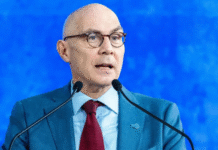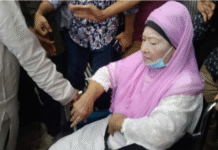
Long-term rehabilitation and comprehensive support are neededfor the families of those killed and injured during the July uprising, speakers said at an event yesterday.
They said many families have lost their sole breadwinners, while injured survivors are unable to return to their previous professions due to their injuries, adding that the financial assistance provided by the July Smriti Foundation is insufficient and demeaning.
They made the remarks at a discussion titled “Marginalised Voices of the July Revolution,” organised by The Daily Star at its photo exhibition and storytelling week — “36 Days of July: Saluting the Bravehearts”. It focused on the stories of struggle, sacrifice, and resilience of workers affected by the movement.
Md Jobaer Hasan recounted how his 15-year-old brother Julfiqar had been missing for six days before being found in the DMCH Burn Unit.
“His eye was completely damaged, and over 100 shotgun pellets were lodged in his body,” Jobaer said.
Julfiqar’s mother, who had raised her two sons with support from others, pleaded, “Doctors said his eye cannot be healed, even [if he is taken] abroad. But I want the government to help him regain his sight.”
Shariful Islam, a private service holder who sustained bullet wounds on August 5, shared his experience of facingapathy from hospital authorities and the lack of state support.
He said he had to visit the July Smrity Foundation himself to receive financial aid.
Shariful said he dreams of a new Bangladesh that is free of discrimination, where everyone has enough to eat, voting rights are upheld, grassroots voices are heard, and police serve the people.
According to the speakers, 80 percent of those killed during the July uprising were not students but workers, including rickshaw-pullers, and homeless individuals. Despite their sacrifices, these communities are being erased from the narrative.
“If we fail to include them as stakeholders in building a new Bangladesh, we are not heading towards true democracy,” said Mahfuzur Rahman Shamim, convener of Bangladesh Janatar Sangsad.
He criticised the tendency to label protesting marginalised groups, like battery rickshaw-pullers, as accomplices of fascists. He also saidthe government, like its predecessor, sided with RMG owners rather than the workers when discussing wages.
Asadul Islam, central office secretary of Bangladesh Garment Sramik Samhati, criticised the lack of recognition of RMG workers who played a key role in the uprising, many of whom were injured or killed.
“Their sacrifices remain unacknowledged, except for a few cases highlighted in the media,” he said, calling the Tk 1 lakh compensation for injured families “alms, not compensation”.
Prabir Saha, assistant general secretary of the same platform, stressed the need to honour RMG workers and implement the 18-point demands submitted to the interim government.
“The demands include attendance bonuses, minimum wage reform, an eight-hour workday, labour law reforms, and constitutional changes to ensure workers’ dignity.”
Rickshaw-puller Noor Muhammad recalled being forced by police to take martyredGolam Nafiz’s injured body on his rickshaw on August 4.
After being turned away from hospitals, Noor eventually arranged for an autorickshaw to take Nafiz to Shaheed Suhrawardy Medical College and Hospital.
Noor cried, “No mother should lose her child this way.”
Pria Khan, a member of the Hijra community, shared how she and her peers tirelessly served at DMCH from July 17, witnessing a relentless wave of death bodies, particularly on July 19.
“There were bodies arriving on stretchers, in ambulances, and even on rickshaws. There was no one to carry them inside…. I remember a BRAC University student being brought in by ambulance. I tried to carry him inside but couldn’t do it alone. I begged for help, but he died before we could take him inside.”
Pria revealed the contributions of her community. “Our group of five Hijras collected 730 bags of blood, and our Guru Ma raised Tk 3 lakh in just two days for the treatment of the injured.
“Three morgues were overflowing, with bodies lying out in the open. By July 24, the stench of decay filled the air, and there wasn’t even space to stand or sit. Ambulances charged Tk 10,000-15,000 to transport bodies, turning the crisis into a business. I saw more than 1,000-1,500 people die at DMCH alone, yet we still don’t have an accurate death toll.”
Pria also shared how her phone was snatched, videos deleted, and threats issued to silence her for documenting the atrocities.
Rubi, the mother of martyred Rana Talukder, recounted the devastating loss of her 32-year-old son, a driver by profession, who was shot dead near Uttara East Police Station on August 5.
Rana had left home that afternoon with his elder brother, Roni, to celebrate the fall of Sheikh Hasina.
“Hearing gunshots, I went out to bring them back. Rana said he’d find Roni, and they’d return home together,” Rubi said, her voice breaking.
Roni later found Rana shot near the police station. He was rushed to Uttara Modern Medical College Hospital, where he was declared dead at 8:10pm.
Daily Star









